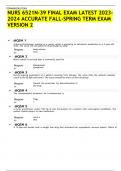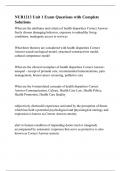Pregnancy Hypertension: An International Journal of Women’s Cardiovascular Health 36 (2024) 101126
Contents lists available at ScienceDirect
Pregnancy Hypertension: An International
Journal of Women's Cardiovascular Health
journal homepage: www.elsevier.com/locate/preghy
Review article
Magnesium sulfate in preeclampsia: Broad indications, not only in
neurological symptoms
Leandro De Oliveira a, b, *, Henri Korkes a, c, Marina de Rizzo a, Monica Maria Siaulys a,
Eduardo Cordioli a
a
Hospital e Maternidade Santa Joana, Centro de Ensino, Pesquisa e Inovação, São Paulo, Brazil
b
Department of Gynecology & Obstetrics, Sao Paulo State University (UNESP), Medical School, Botucatu, SP, Brazil
c
Department of Obstetrics and Gynecology, Faculty of Medicine, Pontifícia Universidade Católica de São Paulo, São Paulo, SP, Brazil
A R T I C L E I N F O A B S T R A C T
Keywords: The role of magnesium sulfate for treatment of eclampsia is well established. The medication proved to be su
Preeclampsia perior to other anticonvulsants to reduce the incidence of recurrent convulsions among women with eclampsia.
Eclampsia Additionally, magnesium sulfate has been indicated for women with preeclampsia with different severe features.
Magnesium sulfate
However, despite these recommendations, many clinicians are still not confident with the use of magnesium
Maternal mortality
Prematurity
sulfate, even in settings with high incidence of preeclampsia and unacceptable rates of maternal mortality. This
Severe hypertension review brings basic science and clinical information to endorse recommendations to encourage clinicians to use
HELLP syndrome magnesium sulfate for patients with all severe features of preeclampsia, not only for women with neurological
symptoms. Additionally, other benefits of magnesium sulfate in anesthesia and fetal neuroprotection are also
presented. Finally, a comprehensive algorithm presents recommendations to manage patients with preeclampsia
with severe features between 34 and 36+6 weeks.
1. Introduction anticonvulsants such as diazepam, phenytoin and lytic cocktail to
reduce the incidence of recurrent convulsions among women with
Preeclampsia affects 8 % of all pregnancies worldwide and is eclampsia [8–10]. Additionally, since the Magpie Trial, magnesium
responsible for more than 70,000 maternal deaths and more than sulfate has been indicated to prevent seizures in women with pre
500,000 perinatal deaths every year [1,2]. The World Health Organi eclampsia [11]. Despite these recommendations, many clinicians are
zation (OMS) reports that 94 % of these deaths occur in low- and middle- still not confident with the use of magnesium sulfate. An interesting
income countries [3]. The causes related to death are eclampsia, stroke, study developed in Brazil, evaluated possible facilitators and barriers
HELLP syndrome, disseminated intravascular coagulation, hemorrhage, regarding the use of magnesium sulfate in preeclampsia [12]. Authors
kidney injury, liver failure, bronchoaspiration, pulmonary oedema and reported that the medication is currently only administered in referral
acute myocardial infarction [4,5]. Even when death is avoided, adverse maternity hospitals in Brazil and there is no easy access to protocols to
events lead to important maternal morbidity, with psychological effects facilitate magnesium sulfate use. Additional barriers identified in non-
and long term repercussions [6]. referral centers were: 1) primary care units are destined to ambulatory
Although knowledge about the pathophysiology of preeclampsia has scheduling, therefore they do not have equipment to facilitate admin
increased over the last two decades, there is no specific treatment for istration of magnesium sulfate; 2) it has been defined that magnesium
this syndrome. Thus, the use of antihypertensive drugs, clinical and sulfate should be used only by obstetricians, but there is insufficient
laboratory monitoring for timely diagnosis of severe phenotypes of number of these professionals; 3) there are no knowledge transfer pro
preeclampsia and indication of delivery at term must be part of a stan grams to qualify general practitioners for magnesium sulfate use; 4)
dard approach [7]. emergency units prioritize trauma, cardiovascular and cerebrovascular
The role of magnesium sulfate for treatment of eclampsia is well care; 5) protocols do not select magnesium sulfate as a drug for hyper
established. The medication proved to be superior to other tensive disorders; 6) MgSO4 is included in essential list of medications
* Corresponding author at: Hospital e Maternidade Santa Joana, Centro de Ensino, Pesquisa e Inovação, São Paulo, Brazil.
E-mail address: leandro.gustavo@unesp.br (L. De Oliveira).
https://doi.org/10.1016/j.preghy.2024.101126
Received 11 August 2023; Received in revised form 5 April 2024; Accepted 16 April 2024
Available online 25 April 2024
2210-7789/© 2024 Published by Elsevier B.V. on behalf of International Society for the Study of Hypertension in Pregnancy.
, L. De Oliveira et al. Pregnancy Hypertension: An International Journal of Women’s Cardiovascular Health 36 (2024) 101126
only for secondary and tertiary hospitals. These findings may be enor determinant of the clinical phenotype of preeclampsia. Basic science
mous barriers as many healthcare professionals do not have opportunity evidences support an important role for magnesium sulfate in protecting
to get used to the medication in primary and many secondary care units. endothelial cells against different mechanisms of lesions. Therefore,
Defining which patients will benefit from magnesium sulfate is basic science findings support the use of magnesium sulfate for different
crucial to disseminate the knowledge about its use. Recently, Fishel subtypes of preeclampsia. But obviously, this statement must be inter
Bartal & Sibai (2020) revisited the aspects of Eclampsia in the 21st preted with great caution, as it has not been tested in clinical practice
Century [13]. Authors highlighted that up to 40 % of women with (⊕⊕OO/Weak).
eclampsia do not have any preceding symptoms until the onset of sei
zures. This information is important for clinical practice as protection of 3. Clinical Science Evidences
many cases may be a real challenge if a restricted use of magnesium
sulfate is recommended. There is a lack of clinical trials to investigate the use of magnesium
We have taken all clinical aspects involving patients who can prog sulfate in different phenotypes of preeclampsia, but there is good in
ress with preeclampsia and have recommended that the applicability of formation to guide an effective protocol. A systematic review of 15 trials
magnesium sulfate should be seen in broad perspective. Furthermore, compared magnesium sulfate with placebo, other anticonvulsants or
we emphasize that magnesium sulfate is a drug with low toxicity, low other drugs [21]. A planned subgroup analysis by severity of pre
cost and simple to be used by trained health professionals [12]. There eclampsia was developed to define whether a specific group would
fore, the medication is compatible for use in low-income settings, where benefit from therapy with magnesium sulfate. Severe preeclampsia was
adverse outcomes related to preeclampsia/eclampsia need tremendous defined wherever possible as women with two or more signs or symp
concerns. This manuscript presents a suggestive protocol that has been toms of imminent eclampsia, or blood pressure of at least 170/110
recommended in many centers in Brazil and brings basic science and mmHg and 3 + proteinuria or, if on antihypertensive agents, 150/100
clinical evidences to support its implementation. mmHg and 2 + proteinuria. If the definition of severe preeclampsia was
not specified, authors considered the description of severe preeclampsia.
2. Basic Science evidences Six trials (11,444 women) compared magnesium sulfate with placebo or
no anticonvulsant. Magnesium sulfate more than halved the risk of
The effect of magnesium sulfate has been investigated. Holcberg eclampsia in this group of patients (RR 0.41, 95 % CI 0.29 to 0.58). It
et al. (2004) developed an experimental model using human cotyledons also reduced the risk of placental abruption (RR 0.64, 95 % CI 0.50 to
perfused with angiotensin-II (Ag-II), endothelin-I (ET-1) and throm 0.83). Considering the reported systematic review, magnesium sulfate
boxane in the presence or absence of magnesium sulfate [14]. The must be the medication of choice for women with premonitory signs and
medication at a concentration of 7 mg% attenuated the vasoconstriction symptoms of eclamptic seizures such as headache, visual changes,
caused by Ag-II and ET-1. Amash et al. (2010) demonstrated that the vomiting and epigastric pain.
perfusion of cotyledons from patients with preeclampsia with magne Extending a discussion on different phenotypes of preeclampsia that
sium sulfate (6–7 mg%) led to reduction in TNF-alpha secretion on both could benefit from treatment with magnesium sulfate, an interesting
fetal and maternal sides [15]. Other works developed by Amash et al. study evaluated the incidence of eclampsia in women with mild gesta
(2012) demonstrated that placental perfusion with magnesium sulfate tional hypertension when only women with severe gestational hyper
reduced IL-6 and IL-1beta secretion on the maternal side of the placenta tension were given magnesium sulfate [22]. According to the
[16]. These studies support a role for magnesium sulfate in the reduction distribution of clinical conditions, 6,431 women were diagnosed with
of the inflammatory response observed in preeclampsia, mainly at the gestational hypertension, 3,935 met the criteria for severe disease
maternal-fetal interface. (Blood pressure of 140/90 mmHg or greater after 20 weeks of gestation
The role of the angiogenic imbalance between anti-angiogenic in in a woman not known to be chronically hypertensive, proteinuria of 2
preeclampsia is well established [17]. Korish (2012) investigated the + or greater as measured by dipstick in a catheterized urine specimen,
effect of magnesium sulfate therapy on vascular endothelial growth serum creatinine more than 1.2 mg/dL, platelets less than 100,000/μL,
factor (VEGF), placental growth factor (PlGF), nitric oxide (NO) me aspartate transaminase elevated two times above upper limit of normal
tabolites, soluble fms-like tyrosine kinase-1 (sFlt-1) and endoglin (Eng) range, persistent headache or scotomata, persistent epigastric or right-
levels in a rat model of preeclampsia [18]. Magnesium sulfate therapy upper quadrant pain) and were given magnesium sulfate, 2,496
ameliorated systolic hypertension and proteinuria, decreased sFlt-1 and women with non-severe hypertension were not treated with magnesium
Eng levels and increased NO metabolites in animals treated with the sulfate. Eighty-seven women developed eclampsia, for an overall inci
medication. dence of 1 in 828 deliveries, a 50 % increase when compared with 5
Regarding the endothelial damage seen in preeclampsia, several previous years where all women with gestational hypertension were
mediators have been described, including ICAM-1. This molecule is given magnesium sulfate prophylaxis. Of the 2,496 women with non-
responsible for leukocytes recruitment and production of inflammatory severe hypertension who were not treated, 27 had eclampsia (1 in 92).
cytokines. HUVEC cells (Human Umbilical Vein Endothelial Cell) sub A systematic review (2015) of descriptive publications on eclampsia,
mitted to inflammatory stimulus with Bacterial Lipopolysaccharides including the study above, was developed [23]. Authors evaluated 59
(LPS) showed increased expression of ICAM-1 and IL-8 [19]. Co-culture eligible publications for this review. Overall, 21,149 eclamptic women
with magnesium sulfate reduced the expression of these inflammatory from 26 countries (5 Low-income countries, 9 Low- and middle-income
markers via NFk-B. countries and 12 High-income countries) were included for the interest
Endothelial ischemia and inflammatory stimulation lead to the pro of one or more of the selected variables. Out of 3,443 eclamptic women,
duction of ultra-large von Willebrand (ULVW) molecules, which leads to 25 % were normotensive (BP of < 140/90 mmHg); 20 % had mild-to-
intense platelet aggregation and endothelial damage. An interesting moderate hypertension (systolic BP of 140–160 mmHg and/or dia
study using HUVEC cultures and a blood perfusion model demonstrated stolic BP of 90–110 mmHg; 32 % had severe hypertension (systolic BP of
that magnesium sulfate reduced ULVW secretion and promoted endo > 160 mmHg and/or diastolic BP of > 110 mmHg); and 21 % were
thelial integrity [20]. In the absence of magnesium sulfate, endothelial hypertensive but unclassified. Out of 2,163 eclamptic women, 66 % and
cells retracted and detached, impairing endothelial layer. The mainte 27 % had headache and visual disturbances, respectively, preceding the
nance of the endothelial layer is essential to regulate the intracellular occurrence of convulsion. Authors concluded that the findings were
flow of several molecules to promote angiogenesis and control arterial apparently in support of initiating magnesium sulfate prophylaxis to all
tone. women with mild preeclampsia.
The endothelial damage present in different organs is the main Interesting studies also support the use of magnesium sulfate in
2




